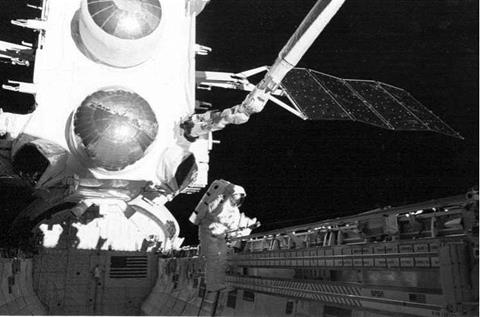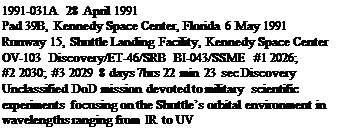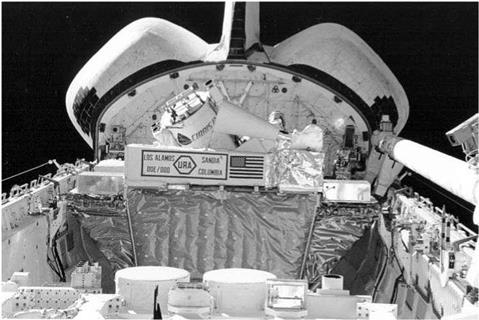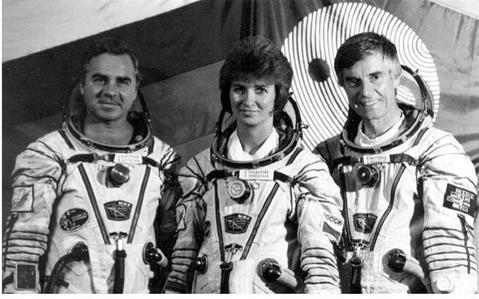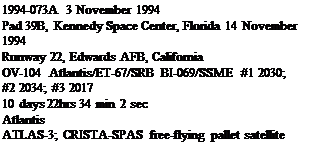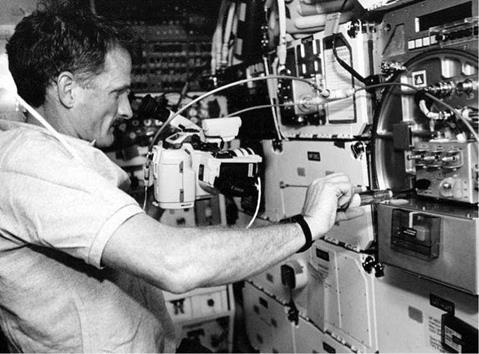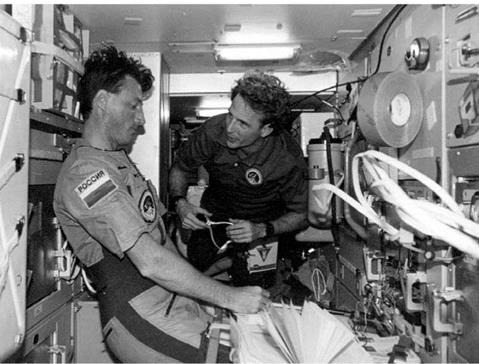Cumulative Space Flight and EVA Experience
Table В.1. Duration log April 1961-September 2006.
Order of most spaceflight experience, up to 29 September 2006 and the end of ISS Expedition 13.
|
Name |
Country |
Flights |
Time in Space (hrs: min) |
|
Sergei K. Krikalev |
USSR/Russia |
6 |
19,258: 57 |
|
Sergei V. Avdeyev |
Russia |
3 |
17,942: 22 |
|
Valery V. Polyakov |
USSR/Russia |
2 |
16,312:34 |
|
Anatoly Y. Solovyov |
USSR/Russia |
5 |
15,624: 13 |
|
Alexandr Y. Kaleri |
Russia |
4 |
14,637:53 |
|
Viktor M. Afanasyev |
USSR/Russia |
4 |
13,339:35 |
|
Yuri V. Usachev |
Russia |
4 |
13,232: 28 |
|
Musa K. Manarov |
USSR |
2 |
12,985:32 |
|
Alexandr A. Viktorenko |
USSR/Russia |
4 |
11,741: 46 |
|
Nikolai V. Budarin |
Russia |
3 |
10,585: 26 |
|
Yuri V. Romanenko |
USSR |
3 |
10,238: 21 |
|
Gennady I. Padalka |
Russia |
2 |
9,377: 29 |
|
Alexandr A. Volkov |
USSR |
3 |
9,373:52 |
|
Yuri I. Onufriyenko |
Russia |
2 |
9,311: 48 |
|
Vladimir G. Titov1 |
USSR/Russia |
4 |
9,288: 47 |
|
Vasily V. Tsibliyev |
Russia |
2 |
9,187: 47 |
|
Valery G. Korzun |
Russia |
2 |
9,158:50 |
|
Pavel V. Vinogradov |
Russia |
2 |
9,136:18 |
|
Alexandr A. Serebrov |
USSR/Russia |
4 |
9,011: 53 |
|
Leonid D. Kizim |
USSR |
3 |
8,993:59 |
|
Table В.1 (cont.) |
|||
|
Name |
Country |
Flights |
Time in Space (hrs: min) |
|
C. Michael Foale |
USA |
6 |
8,970:08 |
|
Valery V. Ryumin |
USSR/Russia |
4 |
8,921: 28 |
|
Vladimir A. Solovyov |
USSR |
2 |
8,686: 51 |
|
Talgat A. Musabayev |
Russia |
3 |
8,021 : 49 |
|
Vladimir A. Lyakhov |
USSR |
3 |
7,998: 49 |
|
Yuri P. Gidzenko |
Russia |
3 |
7,918: 46 |
|
Yuri I. Malenchenko |
Russia |
3 |
7,744: 52 |
|
Gennady M. Manakov |
USSR/Russia |
2 |
7,437: 20 |
|
Alexandr P. Alexandrov |
USSR |
2 |
7,433: 03 |
|
Gennady M. Strekalov1 |
USSR/Russia |
5 |
6,622: 26 |
|
Viktor P. Savinykh |
USSR |
3 |
6,066: 39 |
|
Vladimir N. Dezhurov |
Russia |
2 |
6,029: 28 |
|
Oleg Y. Atkov |
USSR |
1 |
5,686: 50 |
|
Carl E. Walz |
USA |
4 |
5,533: 03 |
|
Leroy Chiao |
USA |
4 |
5,505: 41 |
|
Daniel W. Bursch |
USA |
4 |
5,446:14 |
|
William S. McArthur |
USA |
4 |
5,431 : 06 |
|
Shannon W. Lucid |
USA |
5 |
5,362: 34 |
|
Valentin V. Lebedev |
USSR |
2 |
5,262: 00 |
|
Vladimir V. Kovalenok |
USSR |
3 |
5,194: 12 |
|
Kenneth D. Bowersox |
USA |
5 |
5,077:13 |
|
Anatoly N. Berezovoi |
USSR |
1 |
5,073: 05 |
|
Susan J. Helms |
USA |
5 |
5,044: 47 |
|
Jean-Pierre Haignere |
France |
2 |
5,028: 25 |
|
Edward Tsang Lu |
USA |
3 |
4,956: 48 |
|
James S. Voss |
USA |
5 |
4,854: 32 |
|
Salizhan S. Sharipov |
Russia |
2 |
4,839: 47 |
|
Leonid I. Popov |
USSR |
3 |
4,814: 55 |
|
Valery I. Tokarev |
Russia |
2 |
4,791 : 07 |
|
Jeffrey N. Williams |
USA |
2 |
4,627: 53 |
|
John L. Phillips |
USA |
2 |
4,581 : 54 |
|
E. Michael Finke |
USA |
1 |
4,509:16 |
|
Alexandr I. Lazutkin |
Russia |
1 |
4,441 : 42 |
|
Peggy A. Whitson |
USA |
1 |
4,438:14 |
|
Sergei V. Treshchev |
Russia |
1 |
4,438:14 |
|
Yelena v. Kondakova |
Russia |
2 |
4,299:12 |
|
Thomas Reiter2 |
Germany |
1 |
4,297: 42 |
|
Alexandr N. Balandin |
USSR |
1 |
4,297:18 |
|
Alexandr F. Poleshchuk |
Russia |
1 |
4,296: 44 |
|
Andrew S. W. Thomas |
USA |
4 |
4,182: 03 |
|
Alexandr I. Laveikin |
USSR |
1 |
4,179: 26 |
|
John E. Blaha |
USA |
5 |
3,874: 49 |
|
Table В.1 {cont.) |
|||
|
Name |
Country |
Flights |
Time in Space {hrs: min) |
|
Donald R. Pettit |
USA |
1 |
3,865: 15 |
|
William M. Shepherd |
USA |
4 |
3,823: 51 |
|
David A. Wolf |
USA |
3 |
3,672:33 |
|
Alexandr S. Ivanchenkov |
USSR |
2 |
3,540: 39 |
|
Vladimir A. Dzhanibekov |
USSR |
5 |
3,495:59 |
|
Anatoly P. Artsebarsky |
USSR |
1 |
3,471 : 22 |
|
Norman E. Thagard |
USA |
5 |
3,541: 28 |
|
Frank L. Culbertson, Jr. |
USA |
3 |
3,446:50 |
|
Jerry M. Linenger |
USA |
2 |
3,435:50 |
|
Georgi M. Grechko |
USSR |
3 |
3,236:33 |
|
Mikhail V. Tyurin2 |
Russia |
1 |
3,092: 45 |
|
Gerald P. Carr |
USA |
1 |
2,017:16 |
|
Edward G. Gibson |
USA |
1 |
2,017:16 |
|
William R. Pogue |
USA |
1 |
2,017:16 |
|
Sergei V. Zaletin |
Russia |
2 |
2,008:35 |
|
Vital I. Sevastyanov |
USSR |
2 |
1,936:19 |
|
Pyotr I. Klimuk |
USSR |
3 |
1,890:19 |
|
Owen K. Garriott |
USA |
2 |
1,674:56 |
|
Alan L. Bean |
USA |
2 |
1,671: 45 |
|
Jack R. Lousma |
USA |
2 |
1,619:14 |
|
Franklin R. Chang-Diaz |
USA |
7 |
1,600: 24 |
|
James D. Wetherbee |
USA |
6 |
1,594: 27 |
|
Kent V. Rominger |
USA |
5 |
1,586:58 |
|
Vladimir V. Vasyutin |
USSR |
1 |
1,557:52 |
|
Kenneth D. Cockrell |
USA |
5 |
1,548 : 30 |
|
Tamara E. Jernigan |
USA |
5 |
1,500: 29 |
|
Jerry L. Ross |
USA |
7 |
1,392:55 |
|
Curtis L. Brown, Jr. |
USA |
6 |
1,358:54 |
|
Marsha S. Ivins |
USA |
5 |
1,342: 26 |
|
F. Story Musgrave |
USA |
6 |
1,280:50 |
|
Thomas D. Jones |
USA |
4 |
1,271: 53 |
|
Kevin R. Kregel |
USA |
4 |
1,265: 22 |
|
James D. Halsell, Jr. |
USA |
5 |
1,260:35 |
|
Boris V. Volynov |
USSR |
2 |
1,255: 20 |
|
Wendy B. Lawrence |
USA |
4 |
1,227:57 |
|
Jeffrey A. Hoffman |
USA |
5 |
1,210: 51 |
|
Bonnie J. Dunbar |
USA |
5 |
1,209: 24 |
|
Ulf D. Merbold |
Germany |
3 |
1,207:37 |
|
Steven W. Lindsey |
USA |
4 |
1,203:32 |
|
Vitaly M. Zholobov |
USSR |
1 |
1,182: 24 |
|
Table В.1 (cont.) |
|||
|
Name |
Country |
Flights |
Time in Space (hrs: min) |
|
Janice E. Voss |
USA |
5 |
1,181: 51 |
|
Charles Conrad, Jr. |
USA |
4 |
1,179: 39 |
|
Peter J. K. Wisoff |
USA |
4 |
1,064: 51 |
|
Richard M. Linnehan |
USA |
3 |
1,049: 49 |
|
Joseph R. Tanner |
USA |
4 |
1 ,045 : 16 |
|
Jean-Loup J. M. Chretien |
France |
3 |
1,043: 19 |
|
Donald A. Thomas |
USA |
4 |
1,042: 14 |
|
James H. Newman |
USA |
4 |
1,042: 10 |
|
Michael L. Gernhardt |
USA |
4 |
1,041: 05 |
|
Scott J. Horowitz |
USA |
4 |
1,139: 42 |
|
Claude Nicollier |
Switzerland |
4 |
1,029: 02 |
|
Thomas T. Henricks |
USA |
4 |
1 ,026 : 40 |
|
Michael E. Lopez-Alegria2 |
USA |
3 |
1,022: 25 |
|
Scott L. Parazynski |
USA |
4 |
1,021: 09 |
|
John M. Grunsfeld |
USA |
4 |
1,108: 08 |
|
Terrence W. Wilcutt |
USA |
4 |
1,009: 03 |
|
Brent W. Jett Jr. |
USA |
4 |
1,003: 42 |
|
Nancy J. (Sherlock) Currie |
USA |
4 |
999:34 |
|
Brian Duffy |
USA |
4 |
978:39 |
|
Kathryn C. Thornton |
USA |
4 |
973:27 |
|
Michael A. Baker |
USA |
4 |
965:40 |
|
Stephen L. Smith |
USA |
4 |
960:17 |
|
Richard A. Searfoss |
USA |
3 |
947:19 |
|
Charles J. Precourt |
USA |
4 |
945 : 46 |
|
Scott D. Altman |
USA |
3 |
927:13 |
|
Linda M. Godwin |
USA |
4 |
918 : 12 |
|
Robert D. Cabana |
USA |
4 |
910:43 |
|
Andrew M. Allen |
USA |
3 |
904:05 |
|
Alexei A. Gubarev |
USSR |
2 |
899:37 |
|
Eileen M. Collins |
USA |
4 |
885:40 |
|
Robert L. Gibson |
USA |
5 |
868:18 |
|
Jay Apt |
USA |
4 |
847:10 |
|
John W. Young |
USA |
6 |
835:42 |
|
Stephen S. Oswald |
USA |
3 |
814:33 |
|
Richard N. Richards |
USA |
4 |
814:30 |
|
Thomas D. Akers |
USA |
4 |
813:45 |
|
Janet L. Kavandi |
USA |
3 |
812:11 |
|
Stephen K. Robinson |
USA |
3 |
807:42 |
|
John H. Casper |
USA |
4 |
805:32 |
|
Gregory J. Harbaugh |
USA |
4 |
797:40 |
|
Paul J. Weitz |
USA |
2 |
793:14 |
|
Mark C. Lee |
USA |
4 |
790:55 |
|
Table В.1 {cont.) |
|||
|
Name |
Country |
Flights |
Time in Space {hrs: min) |
|
Dominic L. Gorie |
USA |
3 |
789:11 |
|
Daniel C. Brandenstein |
USA |
4 |
789:07 |
|
Michael J. Bloomfield |
USA |
3 |
779:02 |
|
Steven A. Hawley |
USA |
5 |
767:44 |
|
Richard J. Hieb |
USA |
3 |
766:37 |
|
Kalpana Chawla3 |
USA |
2 |
758:54 |
|
Vance D. Brand |
USA |
4 |
746:04 |
|
Daniel T. Barry |
USA |
3 |
735:29 |
|
Viktor V. Gorbatko |
USSR |
3 |
732:46 |
|
Margaret R. Seddon |
USA |
3 |
730:23 |
|
David M. Walker |
USA |
4 |
724:32 |
|
Steven R. Nagel |
USA |
4 |
721:36 |
|
James A. Lovell, Jr. |
USA |
4 |
715:05 |
|
G. David Low |
USA |
3 |
714:08 |
|
Carl J. Meade |
USA |
3 |
713 : 14 |
|
Kevin P. Chilton |
USA |
3 |
704:20 |
|
J. J. Marc Garneau |
Canada |
3 |
698:01 |
|
Vladislav N. Volkov |
USSR |
2 |
689:03 |
|
Ellen S. Baker |
USA |
3 |
687:31 |
|
Charles F. Bolden |
USA |
4 |
680:30 |
|
Joseph P. Kerwin |
USA |
1 |
672:50 |
|
William F. Readdy |
USA |
3 |
672:43 |
|
Guion S. Bluford Jr. |
USA |
4 |
688:35 |
|
Jean-Francois A. Clervoy |
France |
3 |
688:35 |
|
Michael R. U. Clifford |
USA |
3 |
666:21 |
|
Jeffrey S. Ashby |
USA |
3 |
664:20 |
|
Paul S. Lockhart |
USA |
2 |
663:25 |
|
Umberto Guidoni |
Italy |
2 |
663:12 |
|
Pierre J. Thuot |
USA |
3 |
654:45 |
|
N. Jan Davis |
USA |
3 |
650:16 |
|
Richard O. Covey |
USA |
4 |
644:11 |
|
Ronald J. Grabe |
USA |
4 |
627:42 |
|
Richard D. Husband3 |
USA |
2 |
617:37 |
|
James M. Kelly |
USA |
1 |
614:24 |
|
Samuel T. Durrance |
USA |
2 |
614:15 |
|
Ronald A. Parise |
USA |
2 |
614:15 |
|
Michael P. Anderson3 |
USA |
2 |
595:07 |
|
Winston E. Scott |
USA |
2 |
591:35 |
|
Mark E. Kelly |
USA |
2 |
590:15 |
|
Donald R. McMonagle |
USA |
3 |
585:15 |
|
Table В.1 (cont.) |
|||
|
Name |
Country |
Flights |
Time in Space (hrs: min) |
|
Charles D. Gemar |
USA |
3 |
581: 39 |
|
Daniel C. Burbank |
USA |
2 |
576:19 |
|
Georgi T. Dobrovolsky |
USSR |
1 |
570:22 |
|
Viktor I. Patsayev |
USSR |
1 |
570:22 |
|
Robert L. Curbeam, Jr. |
USA |
2 |
569:48 |
|
Pamela A. Melroy |
USA |
2 |
569:43 |
|
Frederick W. Sturckow |
USA |
2 |
568:32 |
|
Chiaki Mukai |
Japan |
2 |
567:39 |
|
Piers J. Sellers |
USA |
2 |
566:37 |
|
Eugene A. Cernan |
USA |
3 |
566:16 |
|
Robert L. Crippen |
USA |
4 |
565:48 |
|
Kenneth L. Cameron |
USA |
3 |
562:13 |
|
David R. Scott |
USA |
3 |
546:54 |
|
Yuri V. Lonchakov |
Russia |
2 |
546:24 |
|
Brewster H. Shaw, Jr. |
USA |
3 |
533:53 |
|
Kathryn D. Sullivan |
USA |
3 |
532:49 |
|
David C. Leestma |
USA |
3 |
532:33 |
|
Mario Runco, Jr. |
USA |
3 |
530:49 |
|
Koichi Wakata |
Japan |
2 |
524:25 |
|
Steven G. MacLean |
Canada |
2 |
521:33 |
|
Andrian G. Nikolayev |
USSR |
2 |
519:24 |
|
James F. Reilly II |
USA |
2 |
519:24 |
|
Claudi (Deshays) Haignere |
France |
2 |
514:23 |
|
Thomas K. Mattingly II |
USA |
3 |
508:34 |
|
Thomas P. Stafford |
USA |
4 |
507:44 |
|
Catherine G. Coleman |
USA |
2 |
500:42 |
|
Valery F. Bykovsky |
USSR |
3 |
497:49 |
|
Oleg G. Makarov4 |
USSR |
4 |
497:43 |
|
Leopold Eyharts |
France |
1 |
496:37 |
|
Carlos I. Noriega |
USA |
2 |
494:48 |
|
David C. Hilmers |
USA |
4 |
494:17 |
|
James F. Buchli |
USA |
4 |
490:25 |
|
Ellen L. Ochoa |
USA |
4 |
489:40 |
|
Sidney M. Gutierrez |
USA |
2 |
488:01 |
|
Henry W. Hartsfield, Jr. |
USA |
3 |
482:51 |
|
John M. Lounge |
USA |
3 |
482:23 |
|
Charles D. Walker |
USA |
3 |
477:56 |
|
Frank F. Borman II |
USA |
2 |
477:36 |
|
Roberto Vittori |
Italy |
2 |
474:46 |
|
Roger K. Crouch |
USA |
2 |
473:58 |
|
Gregory T. Linteris |
USA |
2 |
473:58 |
|
Susan L. Still |
USA |
2 |
473:58 |
|
Table В.1 {cont.) |
|||
|
Name |
Country |
Flights |
Time in Space {hrs: min) |
|
Yuri M. Baturin |
Russia |
2 |
473:23 |
|
Svetlana Y. Savitskaya |
USSR |
2 |
473:06 |
|
Reinhold Ewald |
Germany |
1 |
472:35 |
|
Michael L. Coats |
USA |
3 |
463:59 |
|
L. Blaine Hammond Jr. |
USA |
2 |
463:13 |
|
Robert A. R. Parker |
USA |
2 |
462:52 |
|
Byron K. Lichtenberg |
USA |
2 |
461:56 |
|
Mamoru M. Mohri |
Japan |
2 |
460:10 |
|
Frederick D. Gregory |
USA |
3 |
455:08 |
|
Mary Ellen Weber |
USA |
2 |
451:30 |
|
Michel A. C. Tognini |
France |
2 |
450:47 |
|
Pedro F. Duque |
Spain |
2 |
450:44 |
|
Valery N. Kubasov |
USSR |
3 |
449:59 |
|
Pavel R. Popovich |
USSR |
2 |
448 : 29 |
|
Bernard A. Harris, Jr. |
USA |
2 |
438:08 |
|
Charles L. Veach |
USA |
2 |
436:19 |
|
Frederick H. Hauck |
USA |
3 |
434:09 |
|
Yuri N. Glazkov |
USSR |
1 |
425:23 |
|
Ronald M. Sega |
USA |
2 |
420:35 |
|
George D. Nelson |
USA |
3 |
407:54 |
|
Charles E. Brady, Jr. |
USA |
1 |
405:48 |
|
Jean-Jacques Favier |
France |
1 |
405:48 |
|
Robert Brent Thirsk |
Canada |
1 |
405:48 |
|
John O. Creighton |
USA |
3 |
404:25 |
|
Chris A. Hadfield |
Canada |
2 |
402:02 |
|
William G. Gregory |
USA |
1 |
399:10 |
|
Karol J. Bobko |
USA |
3 |
386:04 |
|
Loren J. Shriver |
USA |
3 |
386:00 |
|
Bryan D. O’Connor |
USA |
2 |
383:19 |
|
Charles G. Fullerton |
USA |
2 |
382:51 |
|
William C. McCool3 |
USA |
1 |
382:20 |
|
David M. Brown3 |
USA |
1 |
382:20 |
|
Laurel B. S. Clark3 |
USA |
1 |
382:20 |
|
Ilan Ramon3 |
Israel |
1 |
382:20 |
|
Albert Sacco, Jr. |
USA |
1 |
381:52 |
|
Jay C. Buckey |
USA |
1 |
381:50 |
|
Kathryn P. Hire |
USA |
1 |
381:50 |
|
James A. Pawelczyk |
USA |
1 |
381:50 |
|
Dafydd R. Williams |
Canada |
1 |
381:50 |
|
Maurizio Cheli |
Italy |
1 |
377:41 |
|
Table В.1 (cont.) |
|||
|
Name |
Country |
Flights |
Time in Space (hrs: min) |
|
Yuri P. Artyukhin |
USSR |
1 |
377:30 |
|
Takao Doi |
Japan |
1 |
376:34 |
|
Leonid K. Kadenyuk |
Ukraine |
1 |
376:34 |
|
Richard M. Mullane |
USA |
3 |
356:21 |
|
Martin J. Fettman |
USA |
1 |
344:13 |
|
Sally K. Ride |
USA |
2 |
343:48 |
|
James A. McDivitt |
USA |
2 |
338:57 |
|
James D. A. Van Hoften |
USA |
2 |
337:58 |
|
James P. Bagian |
USA |
2 |
337:54 |
|
Dale A. Gardner |
USA |
2 |
336:54 |
|
James C. Adamson |
USA |
2 |
334:22 |
|
Soichi Noguchi |
Japan |
1 |
333:32 |
|
Charles J. Camarda |
USA |
1 |
333:32 |
|
Philippe Perrin |
France |
1 |
332:36 |
|
Lawrence J. DeLucas |
USA |
1 |
331: 30 |
|
Eugene H. Trinh |
USA |
1 |
331: 30 |
|
John B. Herrington |
USA |
1 |
330:49 |
|
Kenneth S. Reightler, Jr. |
USA |
2 |
327:47 |
|
Guy S. Gardner, Jr. |
USA |
2 |
320:11 |
|
John M. Fabian |
USA |
2 |
316:03 |
|
Richard F. Gordon, Jr. |
USA |
2 |
315:53 |
|
Joseph P. Allen IV |
USA |
2 |
313:59 |
|
William E. Thornton |
USA |
2 |
313:18 |
|
Bruce McCandless II |
USA |
2 |
312:32 |
|
Bruce E. Melnick |
USA |
2 |
311:28 |
|
Mark L. Polansky |
USA |
1 |
309:21 |
|
Paul W. Richards |
USA |
1 |
307:52 |
|
Michael E. Fossum |
USA |
1 |
306:38 |
|
Lisa M. Nowak |
USA |
1 |
306:38 |
|
Stephanie D. Wilson |
USA |
1 |
306:38 |
|
Charles O. Hobaugh |
USA |
1 |
306:37 |
|
Ronald E. Evans, Jr. |
USA |
1 |
301:52 |
|
Harrison H. Schmitt |
USA |
1 |
301:52 |
|
Walter M. Schirra, Jr. |
USA |
3 |
295:13 |
|
James B. Irwin |
USA |
1 |
295:12 |
|
Alfred M. Worden, Jr. |
USA |
1 |
295:12 |
|
Robert F. Overmyer |
USA |
2 |
290:23 |
|
Buzz Aldrin |
USA |
2 |
289:54 |
|
Robert L. Stewart |
USA |
2 |
289:01 |
|
Donald E. Williams |
USA |
2 |
288:34 |
|
Patrick G. Forrester |
USA |
1 |
285:14 |
|
Vladimir V. Aksyonov |
USSR |
2 |
284:15 |
|
Table В.1 {cont.) |
|||
|
Name |
Country |
Flights |
Time in Space {hrs: min) |
|
Yuri V. Malyshev |
USSR |
2 |
284:02 |
|
Daniel M. Tani |
USA |
1 |
283:37 |
|
Igor P. Volk |
USSR |
1 |
283:14 |
|
Richard A. Mastracchio |
USA |
1 |
283:12 |
|
Boris V. Morukov |
Russia |
1 |
283:12 |
|
Christopher J. Ferguson |
USA |
1 |
283:07 |
|
Heidemarie Stefanyshyn-Piper |
USA |
1 |
283:07 |
|
Gerhard P. J. Thiele |
Germany |
1 |
269:40 |
|
Michael Collins |
USA |
2 |
266:06 |
|
Charles M. Duke, Jr. |
USA |
1 |
265:51 |
|
Duane G. Carey |
USA |
1 |
262:11 |
|
Michael J. Massimino |
USA |
1 |
262:11 |
|
Mary L. Cleave |
USA |
2 |
262:02 |
|
Anousheh Ansari |
USA |
1 |
261:05 |
|
Anatoly V. Filipchenko |
USSR |
2 |
261:05 |
|
Frank De Winne |
Belgium |
1 |
260:53 |
|
Andre Kuipers |
Netherlands |
1 |
260:53 |
|
Bjarni V. Tryggvason |
Canada |
1 |
260:27 |
|
R. Walter Cunningham |
USA |
1 |
260:09 |
|
Donn F. Eisele |
USA |
1 |
260:09 |
|
Sandra H. Magnus |
USA |
1 |
259:59 |
|
Fyodor N. Yurchikhin |
Russia |
1 |
259:59 |
|
Stephen N. Frick |
USA |
1 |
259:43 |
|
Rex J. Walheim |
USA |
1 |
259:43 |
|
Lee M. E. Morin |
USA |
1 |
259:43 |
|
Mark N. Brown |
USA |
2 |
249:28 |
|
Russell L. Schweickart |
USA |
1 |
241:01 |
|
Hans W. Schlegel |
Germany |
1 |
239:40 |
|
Ulrich Walter |
Germany |
1 |
239:40 |
|
Vladimir A. Shatalov |
USSR |
3 |
237:59 |
|
Robert C. Springer |
USA |
2 |
237:33 |
|
Yuri G. Shargin |
Russia |
1 |
237:29 |
|
Mark Shuttleworth |
South Africa |
1 |
237:25 |
|
Marcos C. Pontes |
Brazil |
1 |
237:17 |
|
Gregory H. Olsen |
USA |
1 |
237:15 |
|
Nikolai N. Rukavishnikov |
USSR |
3 |
237:11 |
|
Alexandr P. Alexandrov |
Bulgaria |
1 |
236:10 |
|
Konstantin M. Kozeev |
Russia |
1 |
236:00 |
|
Julie Payette |
Canada |
1 |
235:14 |
|
L. Gordon Cooper, Jr. |
USA |
2 |
225 : 15 |
|
Table В.1 (cont.) |
|||
|
Name |
Country |
Flights |
Time in Space (hrs: min) |
|
Joe H. Engle5 |
USA |
2 |
225:01 |
|
John H. Glenn, Jr. |
USA |
2 |
218:38 |
|
Millie E. Hughes-Fulford |
USA |
1 |
218 : 15 |
|
F. Andrew Gaffney |
USA |
1 |
218 : 15 |
|
Donald K. Slayton |
USA |
1 |
217:28 |
|
Alan B. Shepard, Jr.6 |
USA |
2 |
216:17 |
|
Edgar D. Mitchell |
USA |
1 |
216:02 |
|
Stuart A. Roosa |
USA |
1 |
216:02 |
|
Alexei S. Yeliseyev |
USSR |
3 |
214:25 |
|
Dirk D. D.D. Frimout |
Belgium |
1 |
214:09 |
|
Joe F. Edwards. Jr. |
USA |
1 |
212:47 |
|
Abdul Ahad Mohmand |
Afghanistan |
1 |
212:27 |
|
Neil A. Armstrong |
USA |
2 |
206:00 |
|
Richard H. Truly |
USA |
2 |
199:22 |
|
Jon A. McBride |
USA |
1 |
197:24 |
|
Paul D. Scully-Powers |
USA |
1 |
197:24 |
|
Roberta K. Bondar |
Canada |
1 |
193:14 |
|
Ronald E. McNair7 |
USA |
2 |
192:29 |
|
Anna F. Fisher |
USA |
1 |
191:45 |
|
Franco Malerba |
Italy |
1 |
191:11 |
|
Scott J. Kelly |
USA |
1 |
191:11 |
|
Mohammed Ahmed Faris |
Syria |
1 |
191:05 |
|
Foren J. Acton |
USA |
1 |
190:46 |
|
John-David F. Bartoe |
USA |
1 |
190:46 |
|
Roy D. Bridges |
USA |
1 |
109:46 |
|
Anthony W. England |
USA |
1 |
190:46 |
|
Karl G. Henize |
USA |
1 |
190:46 |
|
Mae C. Jemison |
USA |
1 |
190:30 |
|
Vladimir Remek |
Czechoslovakia |
1 |
190:17 |
|
Toktar O. Aubakirov |
USSR |
1 |
190:13 |
|
Franz Viehbock |
Austria |
1 |
190:13 |
|
Miroslaw Hermaszewski |
Poland |
1 |
190:04 |
|
Dennis Tito |
USA |
1 |
190:04 |
|
Anatoly S. Fevchenko |
USSR |
1 |
189:58 |
|
Klaus-Dietrich Flade |
Germany |
1 |
189:57 |
|
Ivan Bella |
Slovakia |
1 |
189:57 |
|
Toyohiro Akiyama |
Japan |
1 |
189:55 |
|
Rakesh Sharma |
India |
1 |
189:41 |
|
Helen P. Sharman |
Britain |
1 |
189:14 |
|
Sigmund Jahn |
Germany |
1 |
188:49 |
|
Bertalan Farkas |
Hungary |
1 |
188:46 |
|
Arnoldo Tamayo Mendez |
Cuba |
1 |
188:43 |
|
Table В.1 {cont.) |
|||
|
Name |
Country |
Flights |
Time in Space {hrs: min) |
|
Pham Tuan |
Vietnam |
1 |
188:42 |
|
Dumitru D. Prunariu |
Romania |
1 |
188:41 |
|
Jugderdemidin Gurragcha |
Mongolia |
1 |
186:43 |
|
William F. Fisher |
USA |
1 |
170:18 |
|
Sultan bin Salman al-Saud |
Saudi Arabia |
1 |
169:39 |
|
Patrick P. R. Baudry |
France |
1 |
169:39 |
|
F. Richard Scobee7 |
USA |
2 |
158:53 |
|
Wubbo J. Ockels |
Netherlands |
1 |
168:44 |
|
Rheinhard A. Furrer |
Germany |
1 |
168:44 |
|
Ernst W. Messerschmid |
Germany |
1 |
168:44 |
|
Alexei A. Leonov |
USSR |
2 |
168:33 |
|
Don L. Lind |
USA |
1 |
168:09 |
|
Lodewijk van den Berg |
USA |
1 |
168:09 |
|
Taylor G. Wang |
USA |
1 |
168:09 |
|
S. David Griggs |
USA |
1 |
167:55 |
|
Edwin J. Garn |
USA |
1 |
167:55 |
|
Terry J. Hart |
USA |
1 |
167:40 |
|
Thomas J. Hennen |
USA |
1 |
166:52 |
|
Rudolfo Neri Vela |
Mexico |
1 |
165:04 |
|
Sherwood C. Spring |
USA |
1 |
165:04 |
|
William A. Anders |
USA |
1 |
147:01 |
|
Judith A. Resnik7 |
USA |
2 |
146:10 |
|
Robert J. Cenker |
USA |
1 |
143:04 |
|
C. William Nelson Jr. |
USA |
1 |
143:04 |
|
Fred W. Haise, Jr. |
USA |
1 |
142:55 |
|
John L. Swigert, Jr. |
USA |
1 |
142:55 |
|
William B. Lenoir |
USA |
1 |
122:14 |
|
Michael J. McCulley |
USA |
1 |
120:39 |
|
Donald H. Peterson |
USA |
1 |
120:24 |
|
Manley L. Carter, Jr. |
USA |
1 |
120:07 |
|
Georgi S. Shonin |
USSR |
1 |
118:42 |
|
Fei Junlong |
China |
1 |
115:33 |
|
Nie Haishengi |
China |
1 |
115:33 |
|
Edward H. White II |
USA |
1 |
97:56 |
|
William A. Pailes |
USA |
1 |
97: 45 |
|
Georgi T. Beregovoi |
USSR |
1 |
94:51 |
|
Ellison S. Onizuka7 |
USA |
2 |
79: 46 |
|
Gary E. Payton |
USA |
1 |
78 : 33 |
|
Valentina V. Tereshkova |
USSR |
1 |
70:50 |
|
Vladimir M. Komarov |
USSR |
1 |
50:54 |
|
Table В.1 (cont.)
|
Notes
1 Does not include September 1983 launch pad abort
2 In Space aboard ISS-14
3 Includes STS-107 duration up to loss of signal
4 Includes 5 Apr Anomaly – Soyuz 18-1 launch abort
5 Includes X-15 flights, three times 10 minutes
6 Includes Mercury 3 sub-orbital flight
7 Inclusive of STS 51-L time through loss of signal
8 Includes Mercury 4 sub-orbital flight
9 Includes Spaceship One flight two times 24 minutes
10 Includes Spaceship One flight
11 Includes X-15 flight, two times 10 minutes
12 Includes X-15 flight, 10 minutes
All flights into space from 12 April 1961 (over 50 miles or 80m) or accidents of intended orbital missions in progress are included. Launch pad aborts prior to launch are not included.
All data correct up to 29 September 2006.
Listings include
1961 Mercury 3 and Mercury 4 completed NASA sub-orbital flights
1962-1968 Thirteen X-15 missions that exceeded 50 mile (80 km) altitude 1975 Soyuz 18-1 launch abort – Mission in progress
1986 STS 51-L Challenger. Mission in progress
2003 STS 107 Columbia – Mission in progress
2004 3 Spaceship One test and X-Prize private commercial flights that exceeded 100-km altitude
Listings do not include
X-15 flights that did not exceed 50 miles (80 km) altitude. Apollo 1 pad fire – pre-mission training simulation Soyuz T10-1 pad abort – mission aborted prior to lift off. Five Shuttle pad aborts prior to SRB ignition
Table В.2. EVA duration log April 1961-September 2006.
Order of most spaceflight experience, up to 29 September 2006 and the end of ISS Expedition 13. Includes all IVAs.
|
Name |
Country |
EVAs |
Duration (hrs: min) |
|
Anatoly Y. Solovyov |
USSR/Russia |
16 |
79: 51 |
|
Sergei V. Avdeyev |
Russia |
13 |
59:52 |
|
Jerry L. Ross |
USA |
9 |
58:18 |
|
Joseph R. Tanner |
USA |
7 |
56: 09 |
|
Viktor M. Afanasyev |
USSR/Russia |
9 |
50: 05 |
|
Stephen L. Smith |
USA |
7 |
49: 49 |
|
Nikolai V. Budarin |
Russia |
9 |
44:54 |
|
Yuri I. Onufriyenko |
Russia |
8 |
42: 43 |
|
Talgat A. Musabayev |
Russia |
8 |
41 : 29 |
|
Sergei K. Krikalev |
USSR/Russia |
8 |
41 : 18 |
|
Piers J. Sellers |
USA |
6 |
41 : 10 |
|
John M. Grunsfeld |
USA |
5 |
37: 45 |
|
Vladimir N. Dezhurov |
Russia |
9 |
37: 23 |
|
Leroy Chiao |
USA |
6 |
36:17 |
|
James H. Newman |
USA |
5 |
35:56 |
|
Musa K. Manarov |
USSR/Russia |
7 |
34:34 |
|
Michael E. Lopez-Alegria1 |
USA |
5 |
33:58 |
|
Pavel V. Vinogradov |
Russia |
8 |
32:50 |
|
Anatoly P. Artsebarsky |
USSR |
6 |
32: 09 |
|
Alexandr A. Serebrov |
USSR/Russia |
10 |
31: 52 |
|
Yuri V. Usachev |
Russia |
7 |
30:50 |
|
Thomas D. Akers |
USA |
4 |
29: 40 |
|
Leonid D. Kizim |
USSR |
7 |
28 : 51 |
|
Vladimir A. Solovyov |
USSR |
7 |
28 : 51 |
|
F. Story Musgrave |
USA |
4 |
26:19 |
|
Mark C. Lee |
USA |
4 |
26: 01 |
|
Jeffrey A. Hoffman |
USA |
4 |
25 : 02 |
|
William S. McArthur Jr. |
USA |
4 |
24:21 |
|
Eugene A. Cernan |
USA |
4 |
24:13 |
|
Daniel T. Barry |
USA |
4 |
23 : 49 |
|
David A. Wolf |
USA |
4 |
23 : 33 |
|
Alexandr Y. Kaleri |
Russia |
5 |
23 : 24 |
|
Michael L. Gernhardt |
USA |
4 |
23 : 16 |
|
Harrison H. Schmitt |
USA |
4 |
23 : 10 |
|
James S. Voss |
USA |
4 |
22: 45 |
|
C. Michael Foale |
USA |
4 |
22: 45 |
|
Gennady M. Strekalov |
USSR/Russia |
6 |
22:31 |
|
Valeri G. Korzun |
Russia |
4 |
22:19 |
|
Gennady I. Padalka |
Russia |
6 |
22: 09 |
|
Charles M. Duke Jr. |
USA |
4 |
21 : 38 |
|
Michael E. Fossum |
USA |
3 |
21 : 29 |
|
Table В.2 {cont.) |
|||
|
Name |
Country |
EVAs |
Duration {hrs: min) |
|
Richard M. Linnehan |
USA |
3 |
21: 21 |
|
Kathryn C. Thornton |
USA |
3 |
21: 11 |
|
James D. A. Van Hoften |
USA |
4 |
20: 45 |
|
John W. Young |
USA |
3 |
20:14 |
|
David R. Scott |
USA |
5 |
20:14 |
|
Stephen K. Robinson |
USA |
3 |
20: 05 |
|
Soichi Noguchi |
Japan |
3 |
20: 05 |
|
John B. Herrington |
USA |
3 |
19:55 |
|
Peter J. K. Wisoff |
USA |
3 |
19:53 |
|
Thomas D. Jones |
USA |
3 |
19: 49 |
|
Robert L. Curbeam Jr. |
USA |
3 |
19: 49 |
|
Alexandr S. Viktorenko |
USSR/Russia |
6 |
19: 42 |
|
Winston E. Scott |
USA |
3 |
19:36 |
|
Franklin R. L.A Chang-Diaz |
USA |
3 |
19:31 |
|
Philippe Perrin |
France |
3 |
19:31 |
|
Carlos I. Noriega |
USA |
3 |
19: 20 |
|
James B. Irwin |
USA |
4 |
19:14 |
|
Vasily V. V. Tsibliyev |
Russia |
6 |
19:10 |
|
Jeffrey N. Williams |
USA |
3 |
19: 09 |
|
Carl E. Walz |
USA |
3 |
18:55 |
|
Vladimir G. Titov |
USSR/Russia |
4 |
18: 47 |
|
Gregory J. Harbaugh |
USA |
3 |
18: 29 |
|
Richard J. Hieb |
USA |
3 |
17: 42 |
|
Pierre J. Thuot |
USA |
3 |
17: 42 |
|
Yuri I. Malenchenko |
Russia |
3 |
17: 21 |
|
James F. Reilly II |
USA |
3 |
16:30 |
|
Gerald P. Carr |
USA |
3 |
15:51 |
|
Edward G. Gibson |
USA |
3 |
15: 20 |
|
E. Michael Fincke |
USA |
4 |
14:54 |
|
Scott E. Parazynski |
USA |
2 |
14:50 |
|
Chris A. Hadfield |
Canada |
2 |
14:50 |
|
Michael J. Massimino |
USA |
2 |
14:34 |
|
Thomas Reiter2 |
Germany |
3 |
14:16 |
|
Rex J. Walheim |
USA |
2 |
14:15 |
|
Lee M. E. Morin |
USA |
2 |
14: 07 |
|
Gennady M. Manakov |
USSR/Russia |
3 |
13: 46 |
|
Owen K. Garriott |
USA |
3 |
13: 44 |
|
Mikhail V. Tyurin1 |
Russia |
3 |
13:35 |
|
William R. Pogue |
USA |
2 |
13:31 |
|
Heidemarie Stefanyshyn-Piper |
USA |
2 |
13: 08 |
|
Takao Doi |
Japan |
2 |
12: 42 |
|
Bruce McCandless II |
USA |
2 |
12:12 |
|
Robert L. Stewart |
USA |
2 |
12:12 |
|
Table В.2 (cont.) |
|||
|
Name |
Country |
EVAs |
Duration (hrs: min) |
|
Sherwood C. Spring |
USA |
2 |
12: 00 |
|
Daniel W. Bursch |
USA |
2 |
11: 46 |
|
Patrick G. Forrester |
USA |
2 |
11: 45 |
|
Joseph P. Allen IV |
USA |
2 |
11: 42 |
|
Dale A. Gardner |
USA |
2 |
11: 42 |
|
William F. Fisher |
USA |
2 |
11: 34 |
|
Charles Conrad Jr. |
USA |
4 |
11: 33 |
|
Valeri I. Tokarev |
Russia |
2 |
11: 05 |
|
Jack R. Lousma |
USA |
2 |
11: 01 |
|
Jerome Apt |
USA |
2 |
10: 49 |
|
Alexandr N. Baladin |
USSR |
2 |
10: 47 |
|
Alan L. Bean |
USA |
3 |
10:30 |
|
Yuri V. Romanenko |
USSR |
4 |
10:16 |
|
Linda M. Godwin |
USA |
2 |
10:14 |
|
Alexandr A. Volkov |
USSR |
2 |
10: 09 |
|
Alexandr F. Poleshchuk |
Russia |
2 |
9:58 |
|
Salizhan S. Sharipov |
Russia |
2 |
9:58 |
|
Kenneth D. Bowersox |
USA |
2 |
9: 46 |
|
Don R. Pettit |
USA |
2 |
9: 46 |
|
Alan B. Shepard Jr. |
USA |
2 |
9: 22 |
|
Edgar D. Mitchell |
USA |
2 |
9: 22 |
|
George D. Nelson |
USA |
2 |
9:13 |
|
Susan J. Helms |
USA |
1 |
8:56 |
|
Alexandr I. Laveikin |
USSR |
3 |
8: 48 |
|
Vladimir A. Dzhanibekov |
USSR |
2 |
8:35 |
|
Claude Nicollier |
Switzerland |
1 |
8:10 |
|
Buzz Aldrin |
USA |
4 |
8: 09 |
|
Daniel Burbank |
USA |
1 |
7:11 |
|
Steven MacLean |
Canada |
1 |
7:11 |
|
Vladimir A. Lyakhov |
USSR |
3 |
7: 08 |
|
Carl J. Meade |
USA |
1 |
6:51 |
|
Andrew S. W. Thomas |
USA |
1 |
6: 21 |
|
Paul W. Richards |
USA |
1 |
6: 21 |
|
Jean-Pierre Haignere |
France |
1 |
6:19 |
|
Edward Tsang Lu |
USA |
1 |
6:14 |
|
Michael R. U. Clifford |
USA |
1 |
6: 02 |
|
Jean-Loup J. M. Chretien |
France |
1 |
5:57 |
|
Tamara E. Jernigan |
USA |
1 |
5:55 |
|
G. David Low |
USA |
1 |
5:50 |
|
Alexandr P. Alexandrov |
USSR |
2 |
5: 45 |
|
Sergei V. Treshev |
Russia |
1 |
5: 21 |
|
Frank L. Culbertson Jr. |
USA |
1 |
5: 05 |
|
Svetlana Y. Savitskaya |
USSR |
1 |
5: 00 |
|
Viktor P. Savinykh |
USSR |
1 |
5: 00 |
|
Table В.2 (cont.)
|














